
Gallery
This gallery is a small selection of the 5600 images in the Photographic Archive. Catalogues containing a selection of the images with a narrative desciption of the source, date, and content of each image are available as a DVD (see Merchandising).
Aerial Views
The aerial views derive principally from photographs taken over the years and which are periodically sold by door to door salesmen. The earliest of these date from the 1950s. As a consequence few homes in the Village do not have a high level aerial view taken from the side of Elston which includes their house and, in some cases, specially commissioned low level views of their own property. However, for copyright reasons they cannot be reproduced here. The Archive includes many others taken by private individuals and the series of pictures commissioned for David Cook’s painting for the Heritage Trail leaflet.
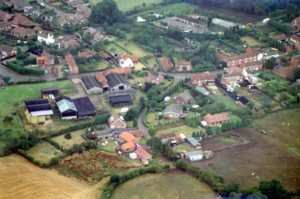
No : AV79
Date : 1990
Medium height view looking South. Low Street and Old Chapel Lane. In the top right are the sheds and greenhouses of Tudor Farm where the houses in Tudor Oaks now stand
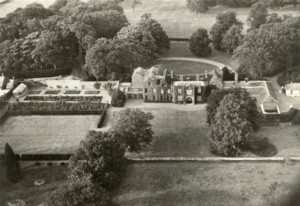
No : AV106
Date : 1934
Low level view of Elston Hall taken by John Darwin, an RAF pilot. The picture was used for the Darwin’s Christmas card of 1934, the last they sent from Elston.
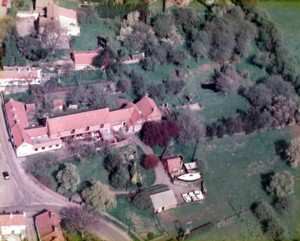
No : AV157
Date : 11 August 2007
View of Sunnyside. Behind Tudor Cottage in the paddock belonging to Sunnyside stood the shell of a horse-drawn bus. It was rescued but its present whereabouts are unknown. The Fete for the Elston Feast used to be held in the paddock. The fruit trees to the rear were planted on the old brickworks. The rear of The Croft on Toad Lane had a lookout post for the foreman to oversee the workforce. In the middle at the bottom of the picture can be seen the foundations of Tudor Cottage.
Ardmore House
The earliest dwelling in the Village is shown in the 1851 census as a bootmakers, but which by 1881 had become a grocers and post office. It was for many years run by Emily Beeston and her cousin Thomas Beeston. Thomas Beeston employed a photographer to take pictures of the Village, in which he always contrived to appear and which can thus be dated to around 1923. It became known as Smith’s Shop from 1939, when it passed into the tenancy of the Smith family. In 1993 it was sold and was renamed Ardmore House. The house, which dates back to the early 17th century, is one of the most photographed cottages in Low Street, alongside Berkley Cottage and The Forge. It was fashionable in the 18th century to clad old timber framed houses with bricks when the original timber work began to deteriorate. The bricks were probably made at one of the two brickyards which once existed in the village
.jpg) No : AH7
No : AH7
Date : 1922/3
The proprietor, Miss Emily Ann Beeston (1850-1939) is standing in the doorway. The gentleman is her cousin, Thomas Beeston (1839-1929), who lived with her. The Post Office licence was transferred to Mrs Eliza Priscilla Spinks (1887-1978) at Appleacre in 1928. The Hudson’s soap sign was recently discovered in the garden but a previous owner had removed the Cadbury’s and Newark Advertiser signs and the scales.
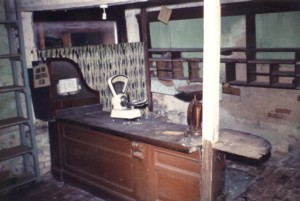
No : AH38
Date : 1992
The ceiling between the beams was constructed of plaster and straw. In 1851 Richard Beeston ran a shoemaker’s shop but by 1861 he had become a grocer. The shop was a post office from 1881 till 1926.

No : AH40
Date : 1992
Stairway up into what is now the main bedroom of Ardmore House prior to renovation. This stair post is made from the iron end of one of the pews that were taken out of the Church, to be replaced by chairs, in 1912, having been there since 1859. The base of the banister is formed from the pew back. These features were removed when the house was renovated. There were two staircases. This is the one in the shop or what was once the cottage fronting onto Low Street.
Art Works
During Dave Sankey's visits to the houses of people who were loaning photographs the occasional artwork on a wall prompted the thought that copies of the many paintings and drawings that have been done over the years by Elston artists and others, should be made part of the Photographic Archive. The collection is but a few of those that are around the village and will eventutally be swelled by a more determined trawl when the main work of the Project subsides.

No : AW3
Date : 1838
Artist : J.Tuke of Lincoln
Medium : Watercolour
One of two paintings in the church that once belonged to the Rev H. R. Harrison, Rector of Elston 1836-53, who is buried in the churchyard. The picture passed to his daughter Mary Ann, wife of Major-General J.F.Willoughby, who presented it to the church after her death on 5 November 1915. It is one of these pew ends that can be seen in the picture of the staircase in Ardmore House.

No : AW23
Date : 1931
Artist : A Radford
Medium : Watercolour
Given to Mary Peatfield by the Rev Charles Wilfred Howard on 13 August 1958. Rev Howard was Rector at Elston from 1922 to 1932 and was over 90 when he sent this from Dulverton Hall, a home for retired clergy in the Lake District, and which had been given to him by the school children when he left the Parish.
 No : AW27
No : AW27
Date : 1927
Artist : V Bryan or V B Ryan
Medium : Watercolour
Painting of the rear of the Hall. In a more accomplished hand than another found with it, which is believed to have been by Vivien Darwin. The signature is quite clear in capitals on this one though it’s less clear whether the B is an initial or part of the surname.
Carrgate Lane
Carrgate Lane is an easterly extension to Low Street. Winston Drive and Darwin Close are off it to the right, and thereafter Carrgate Lane becomes a bridleway leading to Cross Lane. Regrettably few pictures of this quarter of the village, not built until just after the Second World War, have appeared. A Middle Stone Age flint blade, the oldest find in Elston, was found off Carrgate Lane, showing it to have been one of the oldest inhabited parts of the village.
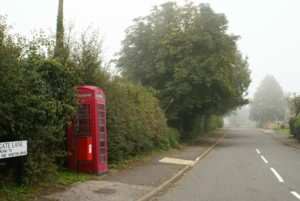
No : CL5
Date : November 2008
View down Carrgate Lane from the junction with Toad Lane. In 2008 the Parish Council were invited by BT to adopt this telephone box or have it removed. Regrettably the cost was prohibitive and BT intended to sell the boxes, made redundant by the use of e-mail and mobile phones.
Elston All Saints Church
All Saints Church is in part a 13th century building on the site of a Saxon church and can boast a list of rectors from 1268. The original 13th century church had a tower, nave, south aisle and chancel. Further building and restoration was carried out in the 14th, 15th, and 17th centuries. The tower was rebuilt in the 17th century. In 1476 John Methley, a lawyer who probably lived where Elston Hall now stands, left money for the south aisle to be lengthened and in 1479, Robert Wright of Elston left money for the building of the south porch.
William Brown Darwin thoroughly repaired the church in 1837 when the top of the tower was rebuilt to make room for the clock and the massive pinnacles at the corners. The original five bells were made in 1793, the sixth bell in 1912. Extensive internal alterations were carried out in 1912, including rebuilding the chancel arch in stone, moving the font, and replacing pews which had originally been installed by William Brown Darwin in 1837, with chairs.
The original Elston rectory stood in the churchyard fronting Top Street. A new rectory, now known as The Old Rectory, was built in 1855 and in the early 1870s the first rectory was demolished. The Old Rectory was itself superseded in that role by a modern house in 1979 on the site of the old coach house.
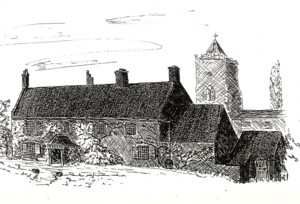
No : CH1
Date : 1835
The first Elston rectory stood in the churchyard fronting Top Street. A new rectory was built in 1855 and in the early 1870s the former rectory was demolished, the site being consecrated as a graveyard in 1873.
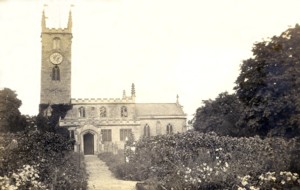
No : CH3
Date : 1870 - 1881
The part of the churchyard nearest the road was the site of the first rectory. The garden and the path to the right leads to an iron gate in the scutchel side of the churchyard opposite a wooden gate leading to the old school garden. Note the heavily overgrown churchyard, the ironwork arch, the weed lined path, and the ivy clad tower.

No : CH132
Date : 1990
The church clock was made by Whitehursts of Derby in 1838 to mark the Coronation of Queen Victoria the previous year. William Brown Darwin had spent £2000 on restoration, including raising the height of the tower to accommodate the clock.
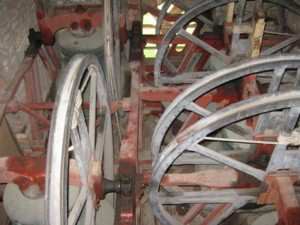
No : CH143
Date : 17 September 2008
The bells in the tower. The original five bells were made by Thomas Osborn at his foundry in Downham Market, Norfolk in 1793, the sixth bell by Messrs Taylor of Loughborough in 1912. The bell ringers' room is on the first floor of the tower. Bell ringers are obviously fit and plucky. This chamber can be accessed only by a near vertical wooden stair. To go even higher up the tower to visit the clock chamber and the roof needs even more fitness and nerve.
Church Tower Views
Views from the church tower derive from five main sources -- Harold Renyard (1961/2), June Mason (1977), Geoff Peabody (1988), Barbara Hiscocks (1994), and Dave Sankey (1997). They therefore illustrate the changes that have taken place in the immediate environs of the church over a period of forty years, showing the greenhouses of Tudor Farm now occupied by the houses of Tudor Oaks, and the appearance of The Green on land formerly occupied by the barns of Rectory Farm.
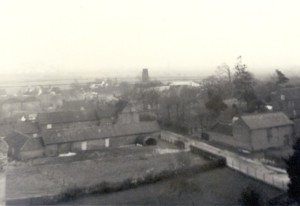
No : CT16
Looking south east over Rectory Farm to what is now The Green, showing the barn of Merrin’s Farm and an adjacent building now demolished and replaced by a wall. Picture taken by Harold Renyard.
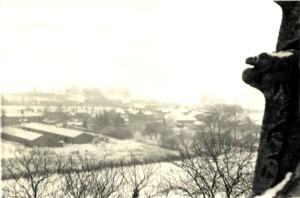
No : CT34
Date : 1977
Looking north towards Low Street. The long sheds on the left are on Tudor Farm. They replaced long greenhouses and were used to grow mushrooms.
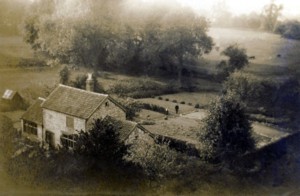
No : CT35
Date : 1922/32
This must be what was on the site of the New Rectory and garden. The figure on the right dressed in black seems to be wearing a white collar and the Rev Howard’s characteristic hat. The New Rectory was built in 1979 described as having been built on the site of a coach house.
Elston Hall
Little is recorded about Elston Hall and even less of the manor house, Garvis Place, that stood on the site. It is forever associated with the Darwin family [see The Darwins and Elston Hall]. The central section was faced with stone and much altered from its original Elizabethan design shortly after the death of Robert Darwin in 1754. Further alterations were carried out in the original Tudor style by William Brown Darwin in 1837. Vacated by the Darwins in 1934, the Hall was then rented by Sidney Shepard, the founder of Bairnswear Ltd and MP for Newark. He died in November 1953. In 1955 the Hall was acquired by Michael Philips, a former headmaster of a preparatory school, and was converted to a Roman Catholic School. The right and left wings were added in the 1960s as student accommodation. In 1970, when an article appeared in the Newark Advertiser, Philips had taken up writing books after the school had closed and was said to be planning to turn the Hall into flats, preserving the older, central portion for himself and his wife. In 1976 the Hall was sold to a developer and turned into 10 dwellings.

No : EH1
Date : Shortly before 1754
Engraving of Elston Hall
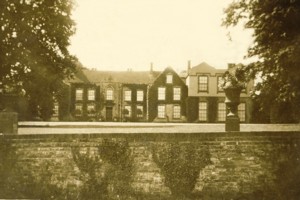
No : EH4
Date : 1922-32
View of the North facade over the garden wall. Note the ornamental flower vases, no longer existing,and the absence of trees. From the album of the Rev. Charles Wilfred Howard, a keen photographer.
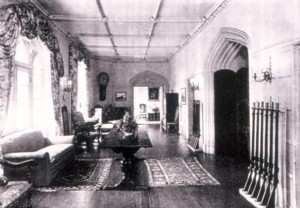
No : EH30
Date : Early 1950s
Entrance Hall, now part of No.5, Elston Hall. The wall paneling has been painted and the double doors to the back garden have been removed and are clearly not in use behind the sofa. The archway at the end leads to a passageway that is now part of No 4.
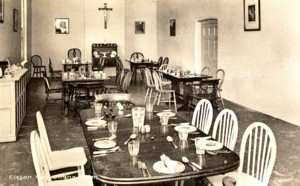
No : EH32
Date : 1955-1970
The dining hall when Elston Hall was a Roman Catholic School
Elston Towers
Middleton House or Elston Towers is situated where Lodge Lane joins the Fosse Way, and is now known as Eden Hall Spa. It was built by Robert Middleton in 1872/5. Middleton was born near Thirsk in Yorkshire in 1814 and died at Elston on 2nd June 1885. The house was built from stone salvaged from the old Trent Bridge at Newark and its furniture included tables from the Tuileries Palace originally used by Napoleon III. It was constructed in the Tudor / Gothic style at a cost of nearly £30,000 (£2,600,000 at 2006 values) and contained a Baptist chapel in the centre, complete with organ and baptistery. There was a tower in the courtyard with 10 bells and a clock which chimed the quarters. A clockwork mechanism operated the bells, which played popular tunes, and was still in working order in 1925. The clock was removed altogether in the 1960s following a fire. The conservatory at the south end once held 2000 plants and was accidentally destroyed in 1942 together with the clock when a Lancaster bomber exploded on Syerston airfield. The conservatory was rebuilt in 2005.
The house has had many varied uses over the years starting as a private house, and being at various times since, a chicken farm, the offices of a water softening firm, of the British Sugar Corporation, of a Rolls Royce motor agents, kennels, an electronics and communications research centre, a maggot breeding factory, the Coeur de Lion restaurant, and now Eden Hall health spa. But overall, it has been unoccupied for longer periods than it was in use.

No : ET10
Date : circa 1912
The Dining Room. This picture, kindly loaned by Eden Hall Spa, shows the main hall when it was owned by Joseph Truman. Middleton died in 1885 and his widow on 26 December 1903.
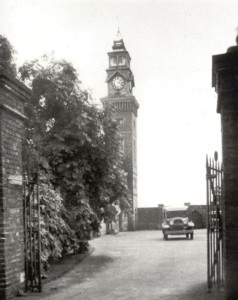
No : ET17
Date : 1920s
Instead of chiming the hours, the bells in the clock tower had a repertoire of 28 popular Victorian melodies such as “Home Sweet Home”, “The Blue Bells of Scotland”, “Oh dear, What can the Matter be ?”, “Rousseau’s Dream,” and “There’s no Luck about the House on a Washing Day.” The clock played a different tune each day of the week and was made by Gillett and Bland of Surrey. The clock was destroyed when the Lancaster exploded in 1942 and the wooden top of the tower burnt down when the building was a maggot factory.
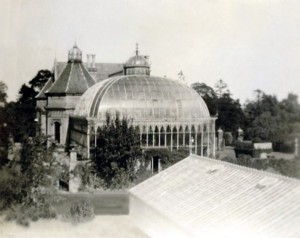
No : ET45
Date : 1930s
Taken from the top of an apple tree by Bill Midwinter, this picture shows the 30ft by 80ft greenhouse. When the Towers later became a maggot factory for 20 years the flies laid their eggs on carcasses in the greenhouse. When their egg laying was over, the carcasses were taken out to be burned in the adjacent tower and the blow flies were released from the top lights. Despite an added steel chimney above the tower to reduce the stench of burning carcasses by releasing it higher into the air, it still allowed the smell to reach Elston as did the blow flies -- described as a little smaller than sparrows.
A larger selection of photographs and an interactive panorama can be found at Heritage Trail / Elston Towers.
Events
This catalogue isn’t nearly as large as it ought to be, as the proportion of photographs of events has been small, and it is remarkable that pictures of the celebrations on VE Day and VJ day and the Queen’s Coronation have not appeared. The reason for this is, in part, that film wasn’t available during the War, but that doesn’t explain the paucity of photographs of other events since. Even now many enthusiastic and imaginative people have gone to a great deal of trouble to arrange celebrations and fund raising events and transformed the Village Hall for the occasion, but no-one seems to think to take a few photographs to record the event itself and all the work that has been put into decorations. Fortunately a number of cine films and videos have come to light which include a day of celebrations of the Silver Jubilee in 1977 and the Golden Jubilee celebrations in 2002. .jpg)
No : EV10.1
Date : circa 1910
Feast Day parade. Another picture of an Elston Wesleyan Quarterly Meeting taken in 1910 shows the same round faced man who is leading this parade. He was George Halstead, a coal merchant from Newark, married to Thirza Bond. Note the old cottages, demolished in the 1950s, next to the Horse and Gears, now The Corner House.

No : EV77.9
Date : 1977
Fancy Dress Competition at the Silver Jubilee celebrations. Other events that day included a pram race round the village, a hog roast, and a street party.

No : EV87.6
Date : 1987
Enthusiastic young warriors participate in the re-enactment on the 500th anniversary of the Battle of Stoke.

No : EV105.7
Date : 30 Sept / 1 Oct 2005
Two performances of "The Triumph of Reason," based on events in the life of Erasmus Darwin, were held in the grounds of Elston Hall over an autumn weekend in 2005. The principal parts were played by Julian Hanby, Andy Barrett and a company of professional actors and supporting roles were played by villagers.
Groups
This catalogue includes Sunday schools, scout troops, religious groups, outings, the art group, cricket and skittle teams, in fact any band of people with common aims and interests even if brought together only for that day. Some groups are completely unidentified so far but have been included in the catalogue in the hope that some day someone will be able to say who they were, if not individually then collectively. I’d welcome any information from anyone who borrows the catalogue or buys a DVD and who could name individuals or date any of the pictures, even if only approximately to a decade.

No : GR5
Date : 1905
Elston Cricket Team. Left to right, back row : Tom Magson, Tom Martin, Tom Price, Henry Doncaster, ……Sweet (gardener at Elston Hall), Harry Jackson (from Flintham), Tom Hawkins (from Syerston), Billy Dixon (of Hollydene in Elston Lane), middle row : Tom Hallam, Alf Martin, unknown, Fred Hawkins (from Syerston), Jack Laughton.

No : GR12
Date : circa 1924
A fete in aid of the Church Missionary Society held on the lawn of The Rectory. The photograph is of a play called “The World Call”. Alice Walker in the centre was the mother and Reg Pile her son. ”South African” children are seated in the front.
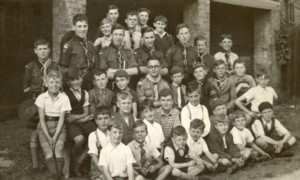
No : GR20
Date : 1941/43
Photograph taken in The Chequers’ yard by Sgt. Leslie Higgins of RAF Syerston, who formed the scout troop and ran it with Cpl Gatoff and Rev Pritchard. They used the club room for meetings. The older boys took part in fire watching and other village activities
Not all are indentified. Back two : George Castle and Peter Wright. Next three : Leslie Clark (evacuee), unknown, Leslie Talbot (evacuee). 3rd row : Bill or Wilfred Mann, Dennis Kitchen, Sid Patterson, Ken Busby, Ken Palmer (from Flintham), Ernest Parks, …..Rick (evacuee). 4th row : David or Victor Hopkinson, Michael or Christopher Shepherd, Ken Bell, Roy Sharpe, Alf Gatoff (cubmaster from Syerston), Noel Walker, Peter Pritchard, Desmond Rick, Kenneth Walker or J.Clark. 5th row : A or Fred Alexander, David Gilbert, Michael Lockwood, ……..Alexander (evacuee), Derek Mann, P Winter. Front row : A Whiteley, Gordon Griffey (evacuee), Roy Whiley (evacuee), Andrew Foster, Frank Foster, Herbert Whiley (evacuee), Ronald Sims.
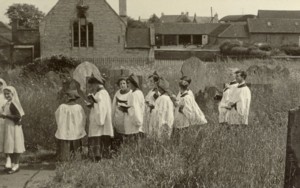 No : GR42
No : GR42
Date : circa 1959
Elston Church Choir. The buildings behind the Schoolhouse are on Rectory Farm, now occupied by The Green. Rose Merrin is looking at the camera next to Hilary Renyard. Behind them is June Costall (later Mrs Ivor Walker). The tall fair haired boy is Paul Renyard. Note the length of the grass, which was cut with a scythe in those days.
The Little Scutchel
Two footpaths connect Low Street with Top Street and are known locally as The Big Scutchel and The Little Scutchel. The word “scutchel” originally meant a fork or a branching, but in this context it is thought to mean “short cut”. The Little Scutchel runs north to south from just opposite The Poplars in Low Street and divides after a hundred yards, one branch continuing through to Paddocks Close and the other turning off right to emerge at the corner of the Village Hall Field, where there is a small cut-through left to the bottom end of The Green. Aside from Villa Cottage most houses in the Little Scutchel were built in the in the early 1960s.

No : SS1
Date :
The Villa used to front on to Toad Lane via a drive, which was taken into Ravenscroft. This shows the front. The back of the Villa then became the front of the renamed Villa Cottage, accessed now from the Little Scutchel, and this side became the back.
Lodge Lane
Lodge Lane runs from the junction of Pinfold Lane with Top Street and is a continuation of Top Street down to the A46. It was believed that Lodge Lane was the main drive to Elston Hall but it appears that the main entrance used to be at what is now the back of the Hall and that the original drive went southwards towards Syerston. There are only two houses in the village itself which are in Lodge Lane plus the Lodge House at the junction with the A46 opposite Eden Hall, from which the road takes its name. Mayfield Cottage next to Elston Hall was demolished in 2007 and replaced with a two storey house.
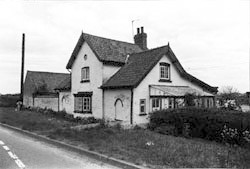
No : LL29
Date : 31 May 1977
Elston Lodge. The round recessed stone above the upper window reads "Elston Lodge 1801". The lodge house was originally built by William Brown Darwin as a place to shelter overnight when awaiting the arrival of the London coach, which would stop there at 5 in the morning. Sometimes the coach was full and he would have to return home three quarters of a mile up the lane
Low Street
Low Street, which has previously been Bottom Street, Nether Street, and Main Street, runs from the junction with Toad Lane and Carrgate Lane on the east to the junction with Pinfold Lane and Elston Lane on the west. It used to be part of East Stoke in what was known as Chapel Parish until 1872. Many of the houses and cottages were built in the 18th century and some in Low Street have date stones. Tudor Farm House has “1710” on one gable and a stone rose on the other, and Elm Cottage has “FF 1724”, Berkley Cottage has “RBH 1720” on it and Ivy House has “TDS 1729”. The central chimney stack of the row of four cottages called Baileys, Cob, Willow, and Rhizome Cottages bears the date 1839. The earliest dwelling in the village is Ardmore House, which dates back to the early 17th century. There was also a fish and chip shop in Low Street in a wooden building at the bottom of the Big Scutchel till about 1960 where The Limes now stands ; the proprietor was Eliza Codd.
The original Wesleyan Methodist Chapel, built in 1815, was near the corner of Pinfold Lane and Elston Lane and was later made into a dwelling, before demolition, probably in the 1960s. Holydene now stands on the site. In 1839 an Independent Primitive Methodist Chapel was built in Low Street, now The White House, and was closed when the present Methodist Chapel was built in 1871. The date stone of the 1815 chapel was placed in front of the present building.
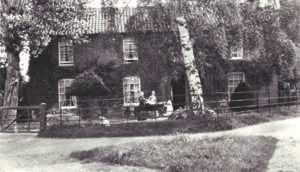 No : LS15
No : LS15
Date : circa 1919
Mrs Ann Elizabeth Lee and her daughter in law, Florence Lee, and granddaughter Mary holding the pram with her baby sister Muriel in it stand in the front garden of The Poplars. There is a small green in the middle of the junction which was removed when the road was later widened by taking in a piece of garden from The Poplars and Woodbine Cottage.
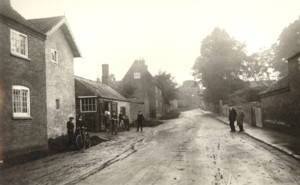
No : LS59B
Date : 1923
The Forge and Tudor Farmhouse behind. Mr Clark is in the white shirt and Mr Beeston, the shopkeeper, is standing on the kerb on the right.
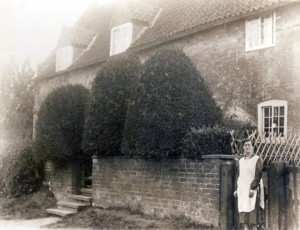
No : LS127
Date : 1920s
Berkley Cottage was owned by the Darwins and occupied by Robert Bateman, a former butler to the Darwins when he retired from service. He lived there till his death in 1904 and named it after his employer's address in Berkeley Square. A subsequent owner had a name plaque made up but an E was missed out. Alice, the first wife of Charles Jabez Bond stands at the gate.
 No : LS152
No : LS152
Date : circa 1907
Jasmine Cottage with Dove Cottage in the background. Left to right : Possibly Gertie Rawson,…….Sweeting (her father was a gardener at the Hall), Ethel Wrath. Mrs Mary Bramley (who lived on Top St), Lucy Long, Mrs Sarah (Sally) Long, Mrs Long (their mother and sister in law to Mary Bramley), Mrs Martin with her daughter Winifred and son, Leslie. The Martins owned the cottages and lived at Ivy House.
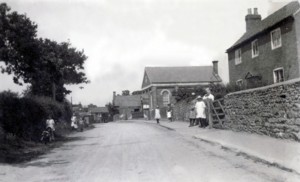
No : LS211
Date : 1923
Chapel Farm and the Wesleyan Chapel. Mrs Thurlby is standing at the gate with Phyllis, Fred, and Albert Bond. Mrs Thurlby lived in the, now derelict, cottage in the entrance to Chapel Farm. Also in the picture are Mary Lee and Mary Bramley.
Mill Road
Mill Road (formerly Mill Lane, and previously, Kilvington Street before the mill was built) begins at the junction of Toad Lane and Top Street and becomes Brecks Lane just outside the village, leading to Shelton, Sibthorpe and Long Bennington. Older buildings begin with Cobbler’s Cottage on the right just past the junction with Top Street. At the bend in the road where the entrance to the Orchards is now, stood Tudor Cottage, formerly “The Blue Bell Inn”, which was pulled down in the early 1960s as unfit for human habitation. On the opposite side of the road stands Rose Cottage, built in 1815. Just this side of the mill on the right hand side where The Pantiles now stands, was a cottage at right angles to the road known only as Gash’s Cottage after the owner. There used to be a brick pit where Dellary now stands.

No : MR8
Date : circa 1960
Tudor Cottage was converted from a beer house called "The Blue Bell." Its interior walls were wattle and daub. Legend has it that highwaymen hid treasure here in a secret chamber up a chimney. It was the oldest complete house in the village until it was demolished in the 1960s, the gate and fence remaining till the late 1990s. It stood across what is now the entrance to The Orchard. There is no surviving documentary evidence for the "The Blue Bell."
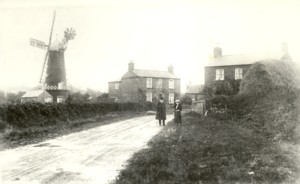
No : MR106
Date : circa 1923
The Old Mill from Brecks Lane. The man is Mr Beeston and the woman is possibly Mrs Green from Millview. There were at one time two mills in Elston. The second stood about half way to the Fosse Way on the south side of Elston Lane where Mill Hill House now stands.

No : MR212
Date : 1978
Exterior of the mill when Mike and Yvonne Lawrence moved in. Over the next few years they worked steadily to convert the derelict mill into an unusual residence. Here Mike can be seen on the scaffolding painting one of the small casements.
Miscellaneous
The miscellaneous catalogue is quite short and mainly consists of photographs of Gash’s buses.
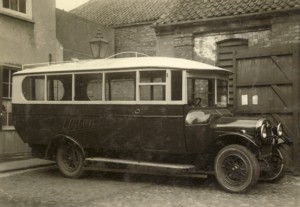
No : MC3
Date : 1926
Gash's first coach, an American REO Sprinter, cost £628 in 1926, or £24,283 at 2006 values. Painted blue and cream, it remained in service for ten years. A roof rack provided for the carriage of general goods and small items of livestock such as chickens.

No : MC15
Date : 1970
Drawing of a Middle Stone Age flint blade, the oldest find in Elston and probably about ten thousand years old. It was found by Richard Sparkes, a pupil at the Village School, who had a great interest in archaeology and who had a large collection of Romano- British pottery fragments from the same area off Carrgate Lane near the bridge over the Car Dyke.
The Old Chapel
The Old Chapel is situated in a field to the north of Elston and on the very edge of East Stoke parish. It is believed that it once formed part of, and is all that now remains of, the mediaeval leper Hospital of St Leonard’s, which was rebuilt in 1577, this being the date inscribed over the outside of the East chancel window and inside the chancel. Another window in the chancel is 14th century and there are similar ones in the nave. The Old Chapel still contains traces of 18th century texts on its inside walls and part of an 18th century Royal Arms. About 1820 box pews were installed. The chapel was in regular use until 1895. By about 1960 it was becoming derelict and subject to vandalism but in 1977 the Churches Conservation Trust carried out emergency repairs. In 1978 the building and the land within the surrounding railings was placed in the hands of the Trust, after which a series of further repair work was undertaken.
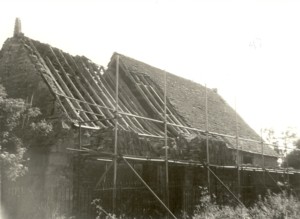
No : OC20
Date : 1977
Roof repairs carried out by the Churches Conservation Trust. The roof was retiled using old pantiles from Manor Farm, which was being retiled at the time.

No : OC32
Date :
One of Harry James’s photographs. The lion is the remains of a royal coat of arms from the Jacobean period. A later Georgian coat of arms is now no longer visible.
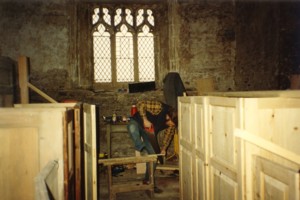
No : OC41
Date : 1993
The pews had all been removed and sent away for restoration and are here shown being reinstalled.
Old Chapel Lane
Old Chapel Lane, as the name implies, is the route to the Old Chapel, but this is a recent name. Towards the bottom of the lane on the right hand side, till 1973, stood a bakery owned by the Doncaster family. It was therefore formerly known as Doncaster’s Lane until 1872. The bakery was demolished and replaced by a cottage called The Old Bakery, the name of which was changed by the subsequent owner to Meadow View in 2005. At the head of the lane where it joins Low Street is The Poplars, the farmhouse to Poplars Farm.
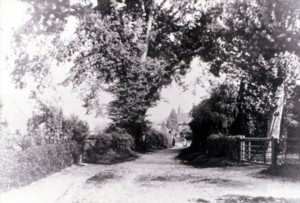 No : OCL4
No : OCL4
Date : 1905
Corner of Old Chapel Lane, then known as Doncaster's Lane. George Greensmith stands under the elm. The people standing at the end of the lane may be John Merrin and his wife who lived in Keeper's Cottage on the left, or the Doncasters who were bakers and lived at the bakery. The poplar trees at Poplar Farm are no longer there. The big elm trees on the left were felled in 1929.

No : OCL12
Date : 1922/3 ?
At the end of the lane can be seen Keeper’s Cottage and The Old Chapel. The fact that this photograph bore the name Elston at the bottom (since removed) and was on the back of a postcard, suggests it may be one of the series produced by Mr Beeston's photographer in 1922/3, though if so, it is unusual for him not to be in it. The stamp on the card bore the head of George V.
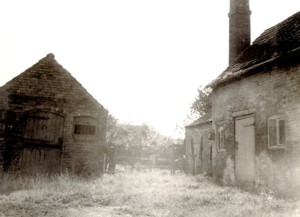
No : OCL15
Date : circa 1973
Doncaster’s Bakery immediately prior to its demolition. Two cottages now occupy the site where these buildings stood ; Chapel Lodge on the right and Meadow View, which had formerly been called The Old Bakery by the previous owner.
People
At the time that the Domesday Book was compiled (1086) there were 21 families living in Elston, comprising 70 to 80 people including children. By 1641 this had risen to 50 families. In 1743 the population was 265 and rose to a peak of 580 by 1851. Thereafter there was a steady decline to a low point of 316 in 1901, after which the population rose again steadily to 650 by December 2006.
So much for numbers ; but what of the people themselves ? Elston is a friendly village where newcomers are quickly assimilated. There is no “Them and Us” – no distinction between those who are born and bred in the village and those who have come here more recently. All are made welcome and, if you are willing to get involved in village activities, there is no warmer welcome to be found anywhere. Partly this is possibly due to Elston’s compact nature – a square of four main streets – where you cannot avoid bumping into people whenever you set foot outside your door. We are not strung out along a main road as many villages are, effectively separating the people at the opposite ends. And we are spared the through traffic, by and large, so that conversations on the street are actually possible. It is a quiet and tranquil place. But mostly it is the nature of the residents themselves, who are friendly, sociable, and welcoming.
This part of the Archive is by far the largest and contains pictures of people at work and at leisure, in solemn poses in the photographer’s studio or at ease having a drink in The Chequers. These are the people who have given Elston its character, attended its gatherings and events and who have thus made it the friendly place it is. This catalogue has served as a rich source of images of those who are no longer with us and whose contribution to the life of the village is celebrated by their inclusion in this Project. This is a small selection of nearly 500 images of people in the Archive. See the section on the Darwins earlier in the website.
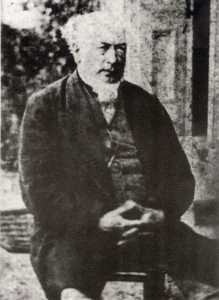
No : PE2
Date : 1870s / 80s ?
Robert Middleton of Elston Towers (1814-1885). Born at Thirsk in Yorkshire, his forebears were in the malting business. When he came into possession of the family fortune he decided to build himself a lavish house and chose a site on the Fosse Way to build Middleton House, later known as Elston Towers, and these days as Eden Hall Spa. He was the pillar of the Lombard Street Congregational Church in Newark and a well known eccentric.
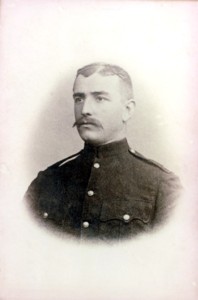
No : PE198
Date : circa 1900
Sam Sterling is seen here in his Boer War uniform. He later served in the First World War and was the gamekeeper to the Darwins until they left Elston Hall in 1934. An interesting article in the Crawford Newsfile describes how he and a companion were attacked by a band of poachers, one of whom was described as carrying a sword and wearing a helmet. Sam was wounded but survived the assault.
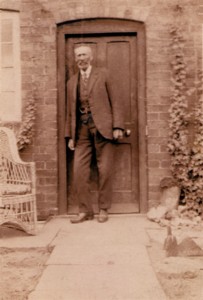
No : PE454
Date : 1914 ?
Thomas Hagues lived at Nashville Cottage. Born at Little Carlton near Newark in 1842, he emigrated to America in 1860. He fought on the Union side and returned to his native village at the end of the War. By 1914 he was living in Elston and was interviewed by the Newark Advertiser. There is a long piece about him in the Elston Index. He died in 1924 and is buried next to his wife in Sheffield. This photograph was supplied by a descendent who is researching his ancestor.

No : PE350
Date : 1918
Captain Joseph Richard Dench MC and two bars of the 5th Battalion, the Sherwood Foresters (1882-1955), earned three MCs in a five week period in the last two months of World War I. A modest man, he never wore the medals but kept them in a suitcase. The first MC was won on 29 September at Lehaucourt when he captured a gun battery and two machine guns. Four days later at Montrehain he organised Lewis gun fire and inflicted heavy enemy casualties while he and his men were under attack. He gained his second bar on 6 November within a week of the Armistice, leading his company over difficult and thickly wooded country at Priches under continuous hostile machine gun fire. He had lived in Elston and later moved to Newark, served in a Home Defence unit in World War II, and died in 1953.

No : PE67
Date :
Rudolf Grundmann, better known as Ralph, was interned in Buchenwald and released when he was able to be offered a job as a farm labourer in England. Born in 1916 in Germany, he married Margret in Sheffield in 1942 and they came to live at Horner's (Stokefields) Farm on 5th November 1942. Their daughter Helen attended Elston Primary School. Ralph died in 1980 and is buried at Wilford Jewish Cemetery.
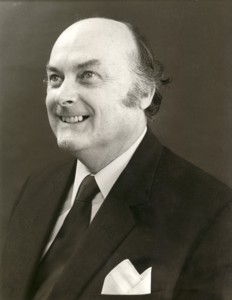
No : PE43
Date : 1972
Ray Merrick, racing driver, environmental engineer, and company director, lived at 8 Paddocks Close. Friend of Graham Hill and Stirling Moss, he competed during the 1950s including the Le Mans 24 hour race against Fangio, Ascari, and many other racing greats. Moss admitted that Ray was the better driver in wet weather. Born at Northfield, Birmingham on 1 February 1918, he died of cancer on 21 September 2003 and is buried in the churchyard.
Pinfold Lane
Pinfold Lane takes its name from “penfold” or “pinfold”, an enclosure for keeping stray cattle or horses until their owners could collect them. The wooden gate and a high hawthorn hedge in front of No 13 are the only remains of the former enclosure. The owner paid a fine to the pinder for rounding them up and keeping them till they were claimed. The last pinder, William Dixon, lived in Hollydene in Elston Lane and died aged 88 in 1920.
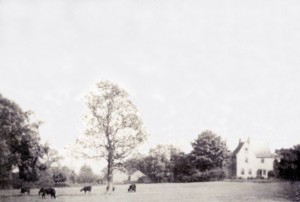
No : PL17
Date : September 1986
Open pasture, perhaps once part of Manor Farm and the garden of The Old Rectory, and now covered by the houses of The Spinney.
Elston All Saints School
A school was endowed in Elston as early as 1614 by the will of a former rector, Laurence Pendleton, but was not actually founded until 1653. Prior to this the schoolmaster taught in the nave of Elston Church. Robert Waring Darwin built a schoolhouse in 1801, which he partly rebuilt in 1812. The school house and the master’s house were situated on the left of Elston Lane on the way to East Stoke, where Sharah House now stands. In 1861 what is now a schoolhouse was built at the Top Street end of The Big Scutchel. In 1872 an infant room was added. Such was the standard that in 1900 it received a commendation by an Inspector as a model village school. Work on the present All Saints Church of England and Methodist School began on the Village Hall Field behind the Church in 1973 and the children moved into the new building on 4th February the following year. The schoolhouse was later converted to a residence and is now known as The Old School House.
.jpg)
No : SC1
Date : 1884
The oldest dated school photograph. The children are not identified. Elston’s school began in1614 with a £50 bequest made by the Rector, Laurence Pendleton, who had died in 1610. The school became a more permanent institution in 1653 when land was purchased to be rented out to provide an income for the schoolmaster who till then had subsisted on the income from the £50 bequest.
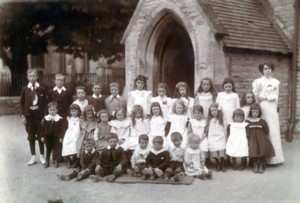
No : SC10.1
Date : Early 1900s
Elston School. Eighth from the left was the girl who would later become Edwin Kirkland's mother.
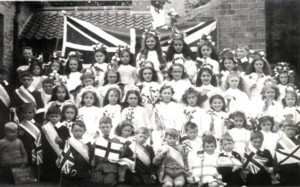
No : SC14.2
Date : 1914
Taken at the declaration of war. Fred Mann is in the top left hand corner. Left to right, back row : 5th Lilly Sterling, 6th Rose Naile, 7th Winnie Martin, 8th ……..Merrin, 11th Margery Merrin, 12th Irene Blatherwick, 2nd row : 6th in front of the tallest girl is Nellie Challand, 7th Mary Hallam, 8th Audrey Sterling (became Audrey Walker), 9th Annie Keyworth, 3rd row : 3rd Ruth Doncaster, 4th Dora North, 6th Carolyn Keyworth, front row, 4th Elsie Kirkland, 6th Reg Price with St George’s flag, 7th Irene Blatherwick.
.jpg) No : SC40
No : SC40
Date : 1940
Some of the children were evacuees from Great Yarmouth. Left to right, Back row, unknown, Sally Pritchard, June Cousins, Gladys Shepherd, Teacher Muriel Lee, Mary Macveigh, Florrie Snell, Iris Kirk, Middle Row : unknown, Joyce Hansard (Bennett), Barbara Yeomans, Olive Gilbert, evacuee, Elsie Kirk, Joyce Sims, Daphne Martin, Front Row : Roy Sharpe, Ken Bell, Albert Baxter, Alan Shepherd, Gilbert Martin, Ron Sims, Chris Shepherd.
The Seasons
This comprises a series of images of snowdrifts and blooming gardens supplemented by the results of periodic tours of the Village during 2007. The result is a portrait of Elston through the changing seasons of emergent spring, blossoming summer, the russet and gold of autumn, to white winter. The views in the Archive are mainly those which can be seen by anyone walking round the village either from, or close to, the road and showing off the natural and cultivated beauty of the gardens, hedgerows, fields and woodland.
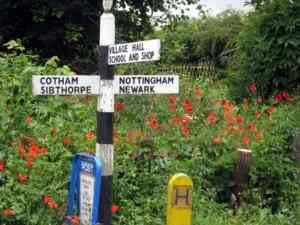
No : SN103E
Date : 10 July 2009
Roadside poppies in Top Street.
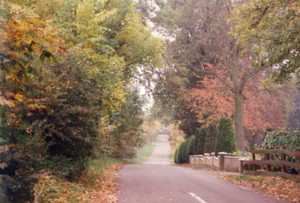
No : SN231
Date : circa 2000
Autumn. Looking down towards Low Street.
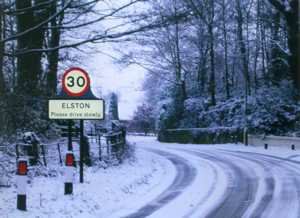
No : SN302
Date : Winter 2006
Bend at the junction of Lodge Lane with Pinfold Lane. This photograph by Chris Allan won First Prize at the 2006 Elston Village Show.
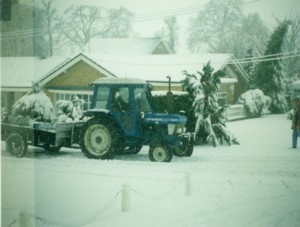
No : SN345
Date : End of October 1990
Ray Lockwood delivering milk in The Spinney with the aid of his tractor.
The Orchard
The Orchard is a small estate of six houses built in 1995 and 1996 on land which was formerly part of the grounds of Sunnyside. The construction of the houses was recorded by Cliff Marshall and his family who occupy three of the new houses. They recorded stage by stage the building of two of the houses and the progress of the whole estate to completion, including some aerial views. Earlier pictures were taken by members of the Renyard family who owned Sunnyside prior to the Marshalls, including images of the ancient Tudor Cottage, pulled down in the early 1960s.
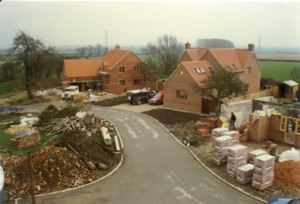
No : OR25
Date : 1996
Building work in progress on No 6 (with scaffolding), No 4 (windows in), and No 2 (walls going up). The photograph was taken by Cliff Marshall sitting astride the ridge of the roof on No 1.
The Paddocks
The Paddocks was built by Able Homes in 1982 on part of Firs Farm. A second phase, called Paddocks Close, was built in 1987 by Langley Homes following the demolition of the main farm complex of cow sheds, storage buildings, and open sided barns. The farmhouse remained standing and was renamed The Firs. The corrugated iron roofed cow sheds and open-sided barns were removed and most of the associated brick-built sheds and barns were recreated as dwelling houses in much the same general style as the buildings they replaced. The sheds alongside Top Street were rebuilt as The Stables, the barn next door to it became Firs Barn, and the dairy on Toad Lane became The Old Dairy.
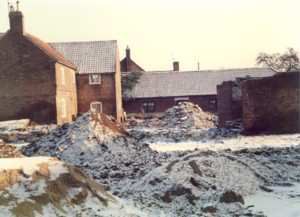
No : PA2
Date : 1987
The demolition of the buildings on Firs Farm took place over several years. The building at the back is the dairy, which stood opposite The Chequers, the roof of which can be seen above to the left. The partly demolished storage building is to the right. The farmhouse, now called The Firs, is to the left. The picture was taken from where the open barns stood.
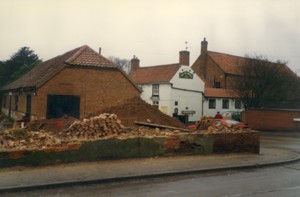
No : PA12
Date : 1987
Demolition of Firs Farm prior to the building of Paddocks Close. The dairy still stands. The Stables would be rebuilt on this corner.
The Spinney
The Spinney was built in three phases in 1969 (Nos 1-13,2-8), 1970 (Nos 7,9,11) and 1972 (the remainder). Few pictures have surfaced of what the Spinney was like before it was built when the land was part of Marsh Farm. Pictures taken from a back garden at the northern end of Pinfold Lane show an open view across to the church and The Old Rectory.
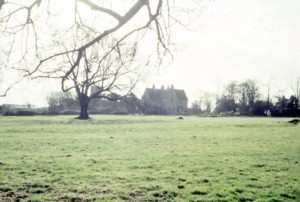
No : SP1
Date : Late 1950s / early 1960s
Looking across to the church and The Old Rectory from the back of Manor Farm before the school and The Spinney were built.
Toad Lane
Toad Lane runs roughly north-south, connecting Top Street with Low Street. The name is a contraction of “The Old Lane.” Few pictures of Toad Lane exist which do not include The Chequers. The reason is that for much of its life Toad Lane has been flanked by a farm on the west and by a brick works on the right. No images of the brickyard have yet come to light and only one old picture of Toad Lane without The Chequers has so far appeared, though individual houses have been photographed. Oakwood Cottage next to The Chequers was a shop until the end of the Second World War and May Cottage was a shop for a very short time. It is regrettable that hardly any pictures of Central Drive, Carrgate Lane, Winston Drive, and Darwin Close have appeared.

No : TL6
Date : circa 1922
The Chequers. The lean-to was a butcher's shop, opened in 1850 by the licencee, Richard Whitworth (1800-1870) and later a beer crate store during the tenancy of George Parkes (1941-45). The adjacent cottage was a small shop, as can be seen by the advertisements on the wall. There was a slaughterhouse in the grounds of Sunnyside behind the pub.
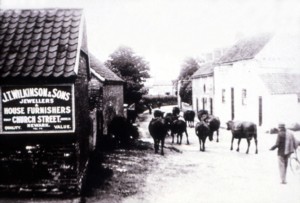
No : TL10
Date : circa 1947
Bob or Tom Merrin leading the Firs Farm dairy cows down to a field in Old Chapel Lane. The walk was timed to avoid the Pit Farm herd from the field opposite the mill.
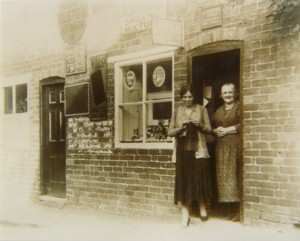
No : TL28
Date : 1930s
The shop next to The Chequers, now Oakwood Cottage. The ladies are Eve Codd and her mother Emma Rawson. In the 1920s the shop was run by Mr Salkeld and his sister. Emma Rawson ran it for three or four years in the 1930s, after which it was tenanted by Miss Todd and her aunt until the end of WWII, when it became a residence.

No : TL56
Date :
The Villa used to front onto Toad Lane via a drive, which was taken into Ravenscroft. The back of the Villa then became the front of Villa Cottage, accessed now from The Little Scutchel. Mr Banks, the village carrier, and his family used to live there.
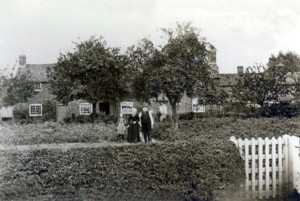
No : TL60
Date : 1912-13
East View Cottages. Mr and Mrs Wrath and their daughter.
Top Street
Top Street contains several historic buildings including The Old Rectory, All Saints Church, The Old Ale House, and a Tudor dovecote behind it. Several farms, all once part of the Darwin estate, also used to abut Top Street and their names are preserved in the houses and cottages. From west to east they are Hall Farm (later known as Merrin’s Farm and now evidenced by The Old Church Barn, The Granaries, The Haywain, and the former farmhouse still known as Hall Farm ) ; Rectory Farm (of which only the farmhouse remains at the corner of The Green), Lineham House Farm (still a working farm) on the south side at the eastern end, and Firs Farm opposite (now evidenced by Firs Barn and The Stables at the junction with Toad Lane). The Old Post Office was a general store and post office until 1999.
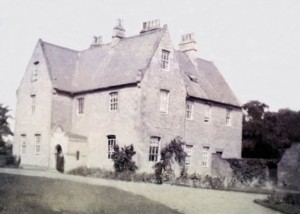
No : TS17
Date : 1922/32
This is from an album of photographs by the Rev Charles Wilfred Howard, shown here with his bicycle at The Rectory. This building was completed in 1855 for the Rev Frederick Swire and served as the rectory until it was itself superseded in that role by a modern house in 1979 on the site of the old coach house, at which point it became known as The Old Rectory.

No : TS87 / 88
Date : 31 July 1905
Glebe (later Rectory) Farm. To the right is the Old Post Office and stores. The wall and gate have since been demolished. The gate let into the crew yard and the doorway (far left) led to the milking parlour. The back of the picture bears the date and the name Blanche Breedon. She was born in 1883, one of 13 children of Henry Breedon who moved to Rectory Farm in 1890.
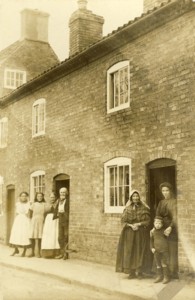
No : TS92 / 93
Date : Perhaps around 1918
Hall Farm Cottages, now The Old Post Office. Granny Blatherwick is in the shawl, with her daughter and grandson. On the left are Thomas and wife Mary Bramley and Margery Merrin, later the mother of Chris Crawford, and her sister Dolly, the daughters of William Merrin of Hall Farm. The cottage nearest Rectory Farm, not visible in this picture, was demolished in about 1951 to provide access to the rear of the other cottages.
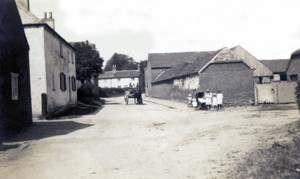 No : TS177
No : TS177
Date : circa 1923
Corner of Top Street and Toad Lane. May Hallam is pushing the pram. The ex-King William IV pub on the left became The Old Alehouse. Mary Peatfield's grandparents lived at the former pub. Sarah Long's cottage behind and the adjacent white cottages were demolished around 1975. The end cottage in the left foreground is Mrs Sewell's little house shop.
Tudor Oaks
Tudor Oaks occupies the site of the former Tudor Farm, which extended from Low Street to the dyke bordering the Village Hall Field. Tudor Farm had been a mushroom farm and the greenhouses where they were grown can be seen in several of the photographs taken by the Lievesley family when they bought the farm in 1981. A small estate of executive houses was built in 1999/2000 by Prowtings, who had originally intended to call the estate Elston Grange. The name appeared on the side of the old Tudor Farm House until someone pointed out that Elston Grange already existed down the Shelton Road so the name was then changed toTudor Oaks. A large pond close to the dyke, which used to function as a holding tank in heavy rainfalls, was filled in, resulting in a high water table for subsequent residents and contributing to flooding problems where the water from the dyke debouches into a narrow culvert under Old Chapel Lane. The building of the new estate was documented by Margret Grundmann, who had a ringside seat from her bedroom window opposite, and comprehensively by Brenda Castle, some of whose land was used and who photographed the heavy traffic from her top floor windows at The Forge.
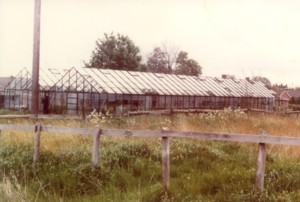
No : TO8
Date : 1981
Tudor Farm greenhouses where the mushrooms were grown.
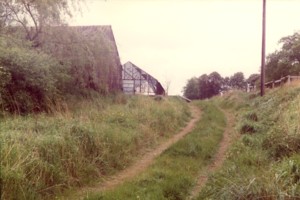
No : TO13
Date : 1981
Driveway to the back field which, twenty years later, would become Tudor Oaks.
Village Hall Field
The Village Hall Field serves as the village green and is bordered by All Saints Church, the grounds of All Saints Primary School, Tudor Oaks, and The Green. A footpath called The Big Scutchel runs alongside the school connecting Top Street with Low Street. Another at right angles to it runs west to east and connects The Spinney with The Little Scutchel and thence to The Paddocks and Paddocks Close. The Old School House, now a private residence, was built here in 1856 and remained in use till the new school was built in 1974. The Village Hall was built in 1959 and in 2005 a portable building was lifted into position next to it and houses Elston Village Shop. The field was used for grazing cattle and sheep and was once gated at both ends. It also provided an area for children to play games and the former swings were replaced with an adventure play area in 2001.
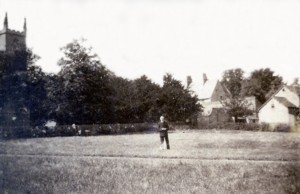
No : VHF5
Date : 1922-32
This shows the Rev Charles Wilfred Howard standing where the school was to be built some 50 years later. Behind him can be seen the Old Rectory and, on the right of the picture, the building which would be converted in 1975 to become the rector's residence.
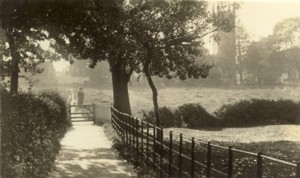
No : VHF2
Date : Early 1920s ?
Miss Ruth Morris, Mrs Beeston's housekeeper at the shop in Low Street, walking along The Big Scutchel. Part of her duties at the shop was to deliver telegrams on her bicycle.
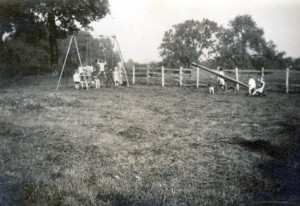
No : VHF6
Date : 1926/7
Children playing on the swings and seesaw presented by Dorothea Darwin in Elston Playing Fields, now the Village Hall car park. There was also a climbing frame.The picture was taken from the back of the schoolhouse. The Village Hall, when subsequently built, would be facing the viewer from behind the fence.
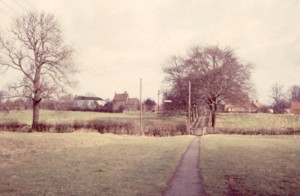
No : VHF8
This scene, reminiscent of a painting by Pissarro or Sisley, shows The Big Scutchell looking towards Low Street from where the Village Hall later stood. No school, no Spinney, no Tudor Oaks.
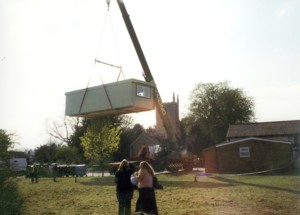
No : VHF46
Date : April 2005
The next big event in the life of the Village Hall Field was the arrival of a portable building for a new village shop. Unfortunately it got wedged in the scutchel and needed a crane to lift it off while the lorry manoeuvred and then lifted it back on again.
Women’s Institute
During the 1940s and 1950s several Elston ladies attended the East Stoke WI, either by bus or on foot. Following the opening of the Village Hall in 1959 a survey was undertaken to measure support for an Elston branch. There was a very positive response from Elston and a great deal of support from the members of East Stoke WI. On 24th January 1962 a meeting was held in the Village Hall with County Organisers attending. The inaugural meeting of Elston WI was held on Thursday 6 February 1962 and Mrs Dallywater, the matron of the Boys’ School at Elston Hall, was elected its first President. It was decided to hold meetings on the second Wednesday of each month - a formula which continues to the present day.
Despite the passing of 47 years the ethos of the WI remains the same - non political and non religious with emphasis on social interaction. The branch remains under the umbrella of County House in Newark, and is part of the national organisation of WIs. In 2008 Elston WI has a growing membership of over forty women.
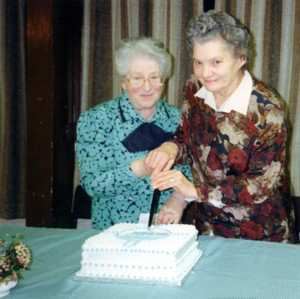
No : WI 53
Date : 1979
Margret Grundmann, the Elston WI’s second President with third President Nellie Sharp, at the celebration of the branch’s17th birthday. The cake was made by Nellie Sharp.

No : W1 58
Date : 1991
Elston’s winning team in the 2001 local WI Darts Championship pictured at The Chequers. Left to right, back : Audrey Joynes, Pat Buckler, Margaret Munday, Almuth Monks, and Pat Turner, front : Megan Merrick and Marguerite Baty.
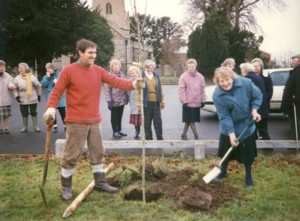 No : EV95.12
No : EV95.12
Date : 1995
WI tree planting to celebrate the centenary of the Parish Council. Chris Crawford and Joan Rowell are planting the first of several trees alongside the Village Hall car park. Behind them (left to right) are Audrey Boswell, Margaret Munday, Pat Buckley, Ivy Sterling, Sybil Hopkinson, Margarite Baty, Maeve Bowler, unknown, Edna Barlow ?, Megan Merrick, Ray Merrick
